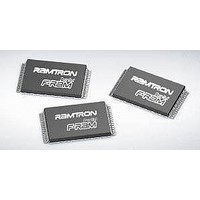FM18L08-70-TG Ramtron, FM18L08-70-TG Datasheet - Page 3

FM18L08-70-TG
Manufacturer Part Number
FM18L08-70-TG
Description
F-RAM 256K (32Kx8) 70ns 3V
Manufacturer
Ramtron
Datasheet
1.FM18L08-70-TG.pdf
(13 pages)
Specifications of FM18L08-70-TG
Memory Size
256 Kbit
Organization
32 K x 8
Interface
Parallel
Access Time
70 ns
Operating Supply Voltage
3 V to 3.65 V
Operating Temperature Range
- 40 C to + 85 C
Package / Case
TSOP-32
Mounting Style
SMD/SMT
Lead Free Status / Rohs Status
Details
Available stocks
Company
Part Number
Manufacturer
Quantity
Price
Part Number:
FM18L08-70-TG
Manufacturer:
RAMTRON
Quantity:
20 000
Overview
The FM18L08 is a bytewide FRAM memory. The
memory array is logically organized as 32,768 x 8
and is accessed using an industry standard parallel
interface. All data written to the part is immediately
nonvolatile with no delay. Functional operation of the
FRAM memory is the same as SRAM type devices,
except the FM18L08 requires a falling edge of /CE to
start each memory cycle.
Memory Operation
Users access 32,768 memory locations each with 8
data bits through a parallel interface. The cycle time
is the same for read and write memory operations.
This simplifies memory controller logic and timing
circuits. Likewise the access time is the same for read
and write memory operations. When /CE is
deasserted high, a precharge operation begins, and is
required of every memory cycle. Thus unlike SRAM,
the access and cycle times are not equal. Writes occur
immediately at the end of the access with no delay.
Unlike an EEPROM, it is not necessary to poll the
device for a ready condition since writes occur at bus
speed.
Note that the FM18L08 contains a limited low
voltage write protection circuit. This will prevent
access when V
operating range. It is still the user’s responsibility to
ensure that V
prevent incorrect operation.
The FM18L08 is designed to operate in a manner
similar to other bytewide memory products. For users
familiar with SRAM, the performance is comparable
but the bytewide interface operates in a slightly
different manner as described below. For users
familiar with EEPROM, the obvious differences
result from the higher write performance of FRAM
technology including NoDelay writes and from
unlimited write endurance.
Read Operation
A read operation begins on the falling edge of /CE.
At this time, the address bits are latched and a
memory cycle is initiated. Once started, a full
memory
regardless of the state of /CE. Data becomes available
on the bus after the access time has been satisfied.
After the address has been latched, the address value
may be changed upon satisfying the hold time
parameter. Unlike an SRAM, changing address values
will have no effect on the memory operation after the
address is latched.
Rev. 3.5
Sept. 2009
cycle
DD
DD
is within data sheet tolerances to
must
is much lower than the specified
be
completed
internally
The FM18L08 drives the data bus when /OE is
asserted to a low state. If /OE is asserted after the
memory access time has been satisfied, the data bus
will be driven with valid data. If /OE is asserted prior
to completion of the memory access, the data bus will
be driven when valid data is available. This feature
minimizes supply current in the system by eliminating
transients caused by invalid data being driven onto
the bus. When /OE is inactive the data bus will
remain tri-stated.
Write Operation
Writes operations require the same time as reads. The
FM18L08 supports both /CE- and /WE-controlled
write cycles. In all cases, the address is latched on the
falling edge of /CE.
In a /CE-controlled write, the /WE signal is asserted
prior to beginning the memory cycle. That is, /WE is
low when /CE falls. In this case, the device begins the
memory cycle as a write. The FM18L08 will not
drive the data bus regardless of the state of /OE.
In a /WE-controlled write, the memory cycle begins
on the falling edge of /CE. The /WE signal falls after
the falling edge of /CE. Therefore, the memory cycle
begins as a read. The data bus will be driven
according to the state of /OE until /WE falls. The
timing of both /CE- and /WE-controlled write cycles
is shown in the electrical specifications.
Write access to the array begins asynchronously after
the memory cycle is initiated. The write access
terminates on the rising edge of /WE or /CE,
whichever is first. Data set-up time, as shown in the
electrical specifications, indicates the interval during
which data cannot change prior to the end of the write
access.
Unlike other truly nonvolatile memory technologies,
there is no write delay with FRAM. Since the read
and write access times of the underlying memory are
the same, the user experiences no delay through the
bus. The entire memory operation occurs in a single
bus cycle. Therefore, any operation including read or
write can occur immediately following a write. Data
polling, a technique used with EEPROMs to
determine if a write is complete, is unnecessary.
Precharge Operation
The precharge operation is an internal condition
where the state of the memory is prepared for a new
access. All memory cycles consist of a memory
access and a precharge. The precharge is user
initiated by taking the /CE signal high or inactive. It
FM18L08
3 of 13














